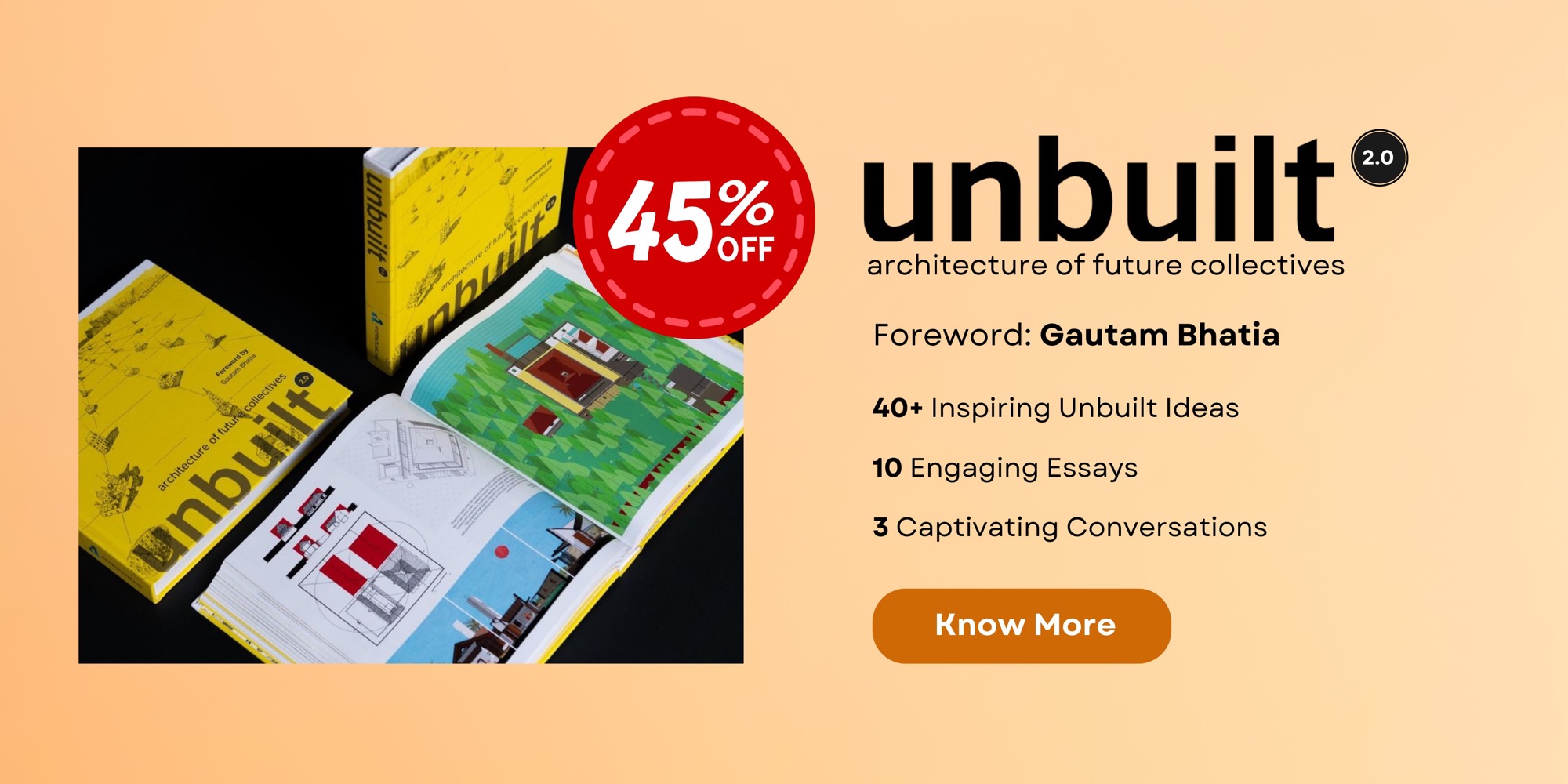Every act of inhabiting is an act of layered forgetting: architecture in the future functions as a dynamic palimpsest, where each new structure overlays prior forms without fully erasing them. Built environments adapt in real time, responsive to climate, movement, and memory, preserving traces of the past while projecting new possibilities. The most valued spaces are those that integrate forgetting as a mode of renewal, enabling continuity through transformation rather than replacement.
The studio Narratives in Architecture, by Meghal Arya and Sonali Gurung, CEPT University, Ahmedabad, approaches architecture as a living narrative, an evolving dialogue between past and future, incorporating time within the conceptual design framework.
The attempt is to view design as a narrative practice that situates buildings and spaces within temporal layers of meaning. This semester, the initiation into this framework started with an exercise titled “Bioscope and Palimpsest”, where the students were challenged to reimagine a university campus twenty years into the future; a speculative exercise grounded in present-day urban realities but open to emerging possibilities. Through the integration of hand drawing and storytelling, the students critically engaged with complex urban conditions, envisioning spaces that are grounded in layered histories and future-oriented.
The first step was to author a drawing that layered concepts from the past, present, and an imagined future, articulating the term “Palimpsest”. Grounded in the spatial reality of an existing university campus, these drawings were reframed through a speculative, future-oriented lens.
To provoke unconventional thinking, students imagined apocalyptic events such as catastrophic flooding from global warming, high-magnitude earthquakes, or alien invasions that ruptured the familiar spatial order. These apocalyptic contexts were deliberately chosen to push students beyond conventional design boundaries and challenge their imagination.
Such speculative disruptions served as provocations to rethink architecture beyond preservation or repair, and instead toward transformation and adaptation.
This approach was informed by Michel de Certeau’s understanding of the palimpsest, not merely as layers written over time, but as “a system of spaces superimposed upon one another” (de Certeau, 1984). This became a method of critical design thinking: students read the campus as a layered spatial field and inscribe new, disruptive narratives upon it, drawing out the tensions between memory, collapse, and renewal.
In the second phase, titled “Bioscope,” students created a series of drawings that unfolded like a timeline, tracing the imagined transformation of the campus. These visual narratives explored the way extreme events like earthquakes, climate crises, and even alien invasions might act as catalysts for reimagining the spatial and architectural life of the campus. This phase extended the concept of the palimpsest: rather than layering in a single frame, students now animated temporal shifts, making visible the continuous rewriting of space through disruption and adaptation.
As Berger (1972) reminds us in Ways of Seeing, how we see is shaped by what we know, and by how we choose to frame it. In this sense, Bioscope operated as a critical lens, zooming in and out of time to expose the layers, ruptures, and continuities that shape built environments. This approach encouraged students to adopt a more holistic perspective, prompting deeper reflection on how built environments evolve in response to changing contexts and unforeseen disruptions.
The students’ work vividly reflects various themes rendered through meticulous hand-drawn sketches, each capturing the layered complexity of the imagined campus. The process reaffirmed the value of hand drawing as a tool for critical observation, spatial thinking, and precise visual storytelling.
In what follows, a selection of student works is presented as narrative prompts, each illustrating a distinct response to apocalyptic disruption and architectural renewal. These examples delve deeper into the way individual students wove speculative events into spatial narratives, transforming crisis into opportunity and imagining the campus as a living palimpsest.
Learning in the cracks of collapse, St. Stephen’s College, New Delhi.
Speculative Campus Narrative by Rushit Shah
Speculating on the future of learning, Rushit Shah envisions a world where education is no longer confined within walls but woven into the dynamic fabric of the city. The future, he suggests, does not comprise consolidated, singular campuses but pods of learning situated within the fabric of the city, along ‘corridors’ of experiences.
A palimpsest reminds us that every space carries the echoes of its past, the reality of its present, and the possibilities of its future. In 2041, Delhi crumbled. The Yamuna ran dry, and a devastating earthquake split the city, swallowing landmarks, including St. Stephen’s College. Years of despair followed until rain returned, bringing with it an unexpected revelation. Life sprouted through the cracks, igniting a radical transformation.
From this ruin emerged a new vision of education: a floating university, suspended by nanocarbon threads, bridging the fractured terrain of the city. More than an institution, it became a living archive of climate catastrophe, urban decay, and technological adaptation, a true palimpsest of resilience. Here, destruction gave way to renewal; memory merged with invention. Students now inhabit this evolving space, continuously adapting to new landscapes, technologies, and ecosystems.
The bioscope of time unfolds around them, mapping learning environments that shift, breathe, and respond to a transforming planet. In Rushit’s vision, the university becomes not just a site of knowledge but a vessel for survival, imagination, and future-making.
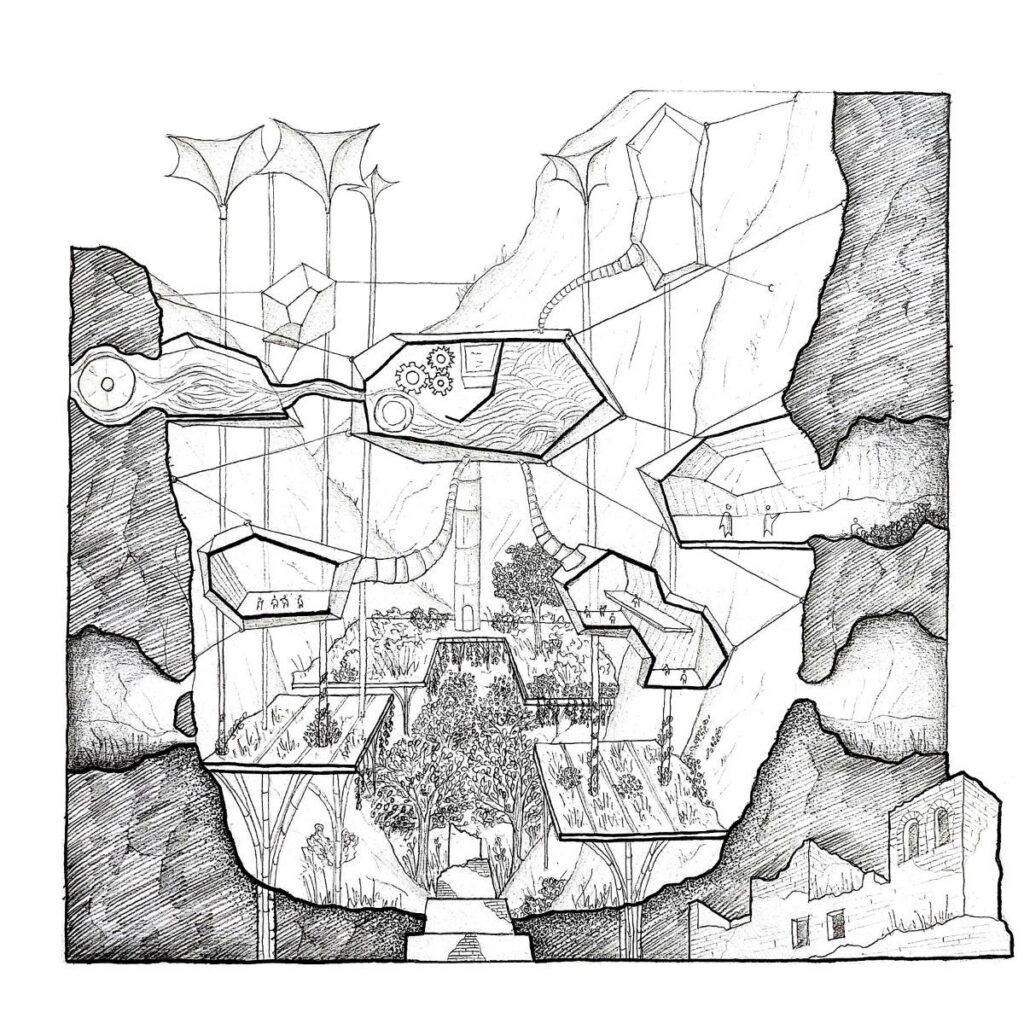

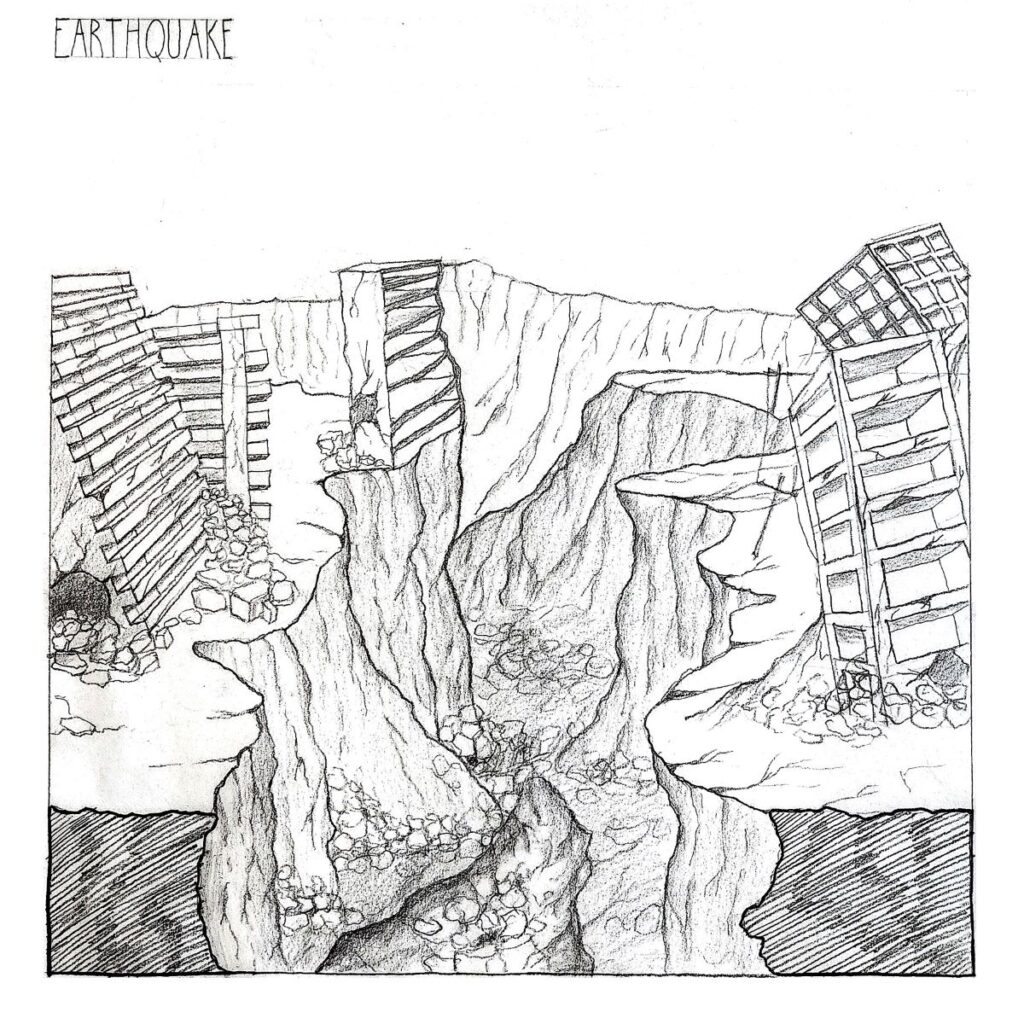

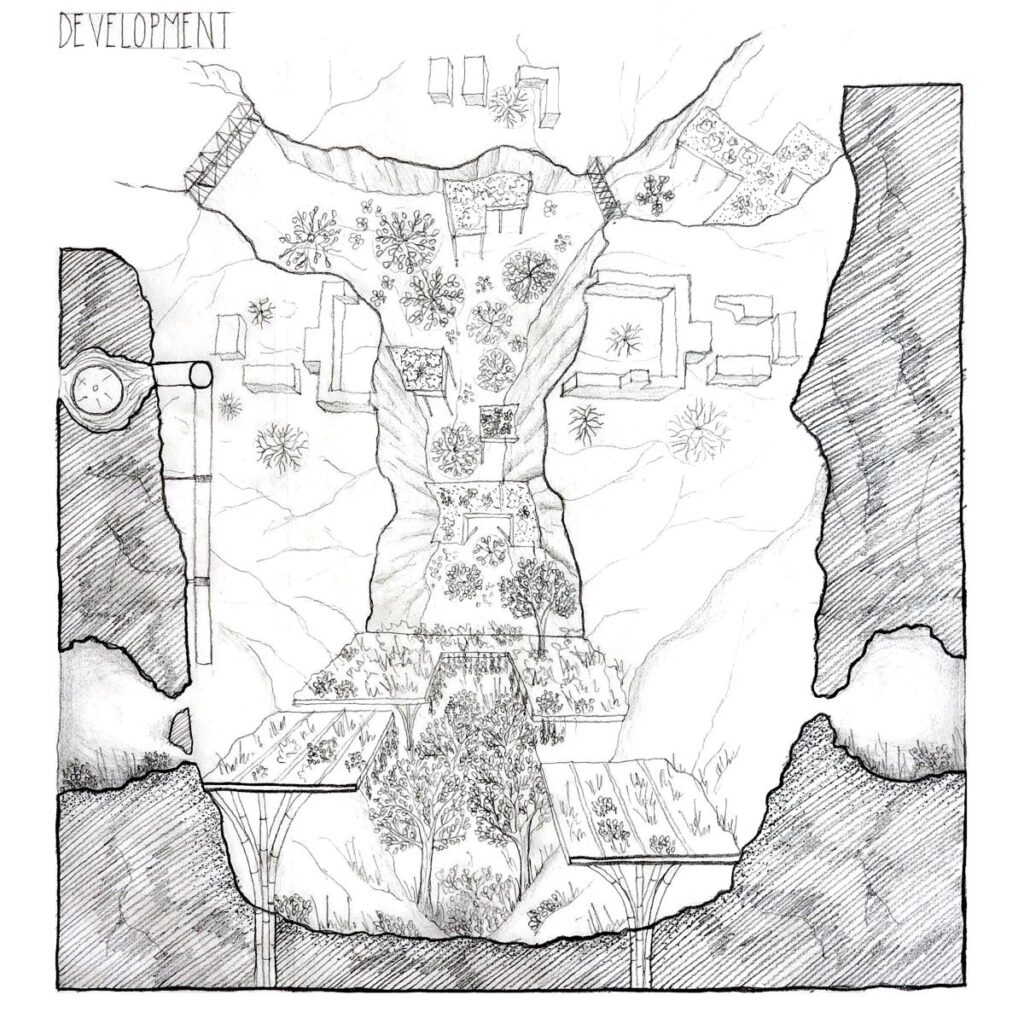
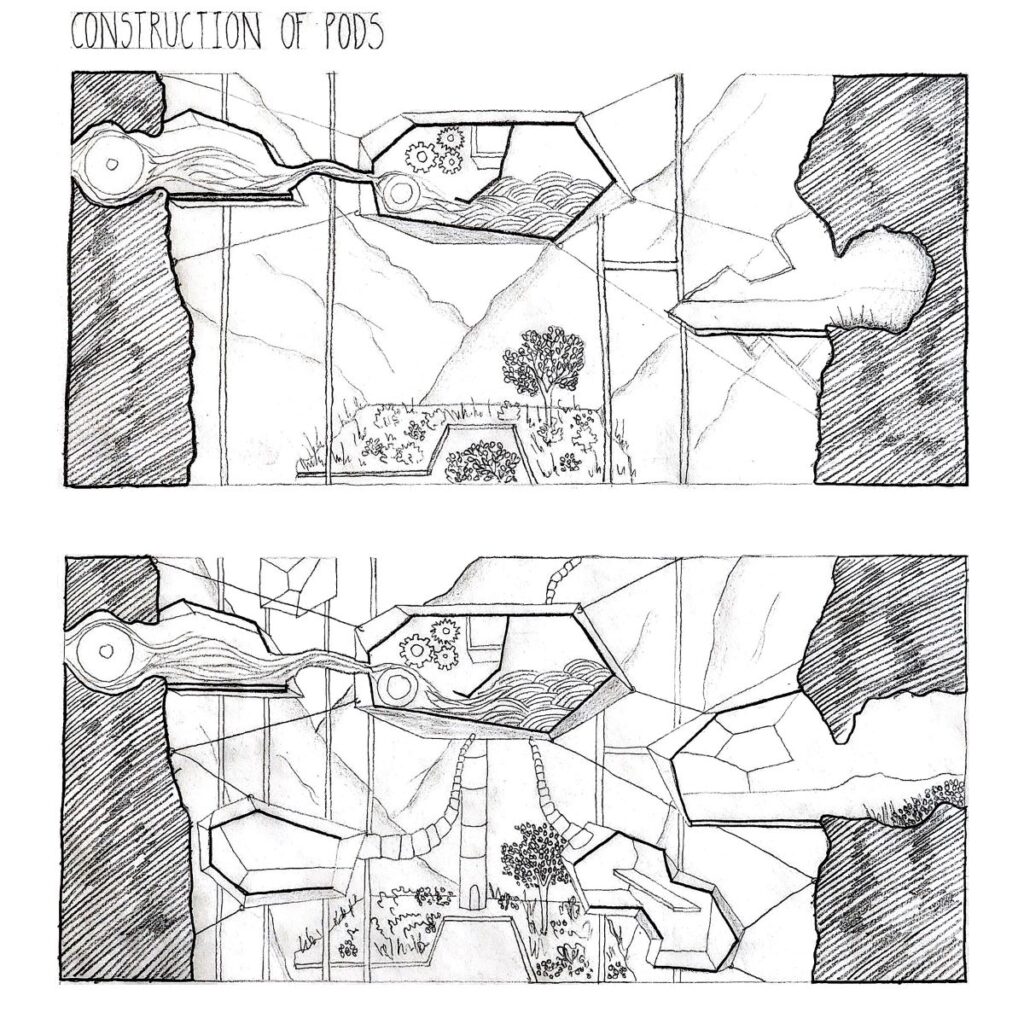

The sunken sanctuary, Bits Pilani’s Underground rebirth
Speculative Campus Narrative by Jiya Bhavsar
Through the bioscope of time, regeneration takes form. BITS Pilani, once a beacon of learning amidst Rajasthan’s golden sands, is now reborn underground.
In 2043, climate change and a devastating earthquake reshaped the region, reducing the once-vibrant campus to ruins. What followed was not retreat, but reinvention. From the fractured terrain emerged a new vision of survival and resilience: a subterranean university. Carved into the earth by students and researchers seeking refuge, this campus became a self-sustaining ecosystem, lit by filtered sunlight, powered by solar energy, and nourished by deep underground reservoirs.
Learning now unfolds in cooled, cavernous halls, shielded from the chaos above. This reimagined institution becomes a living archive of adaptation. It is a palimpsest of innovation, where each subterranean layer tells a story of human ingenuity in the face of collapse.
In these corridors, curiosity endures quiet, focused, and resilient. Jiya’s vision redefines the architecture of education as a space embedded in crisis and regeneration, where history, technology, and the will to survive coalesce beneath the surface, crafting a future shaped by both memory and necessity.





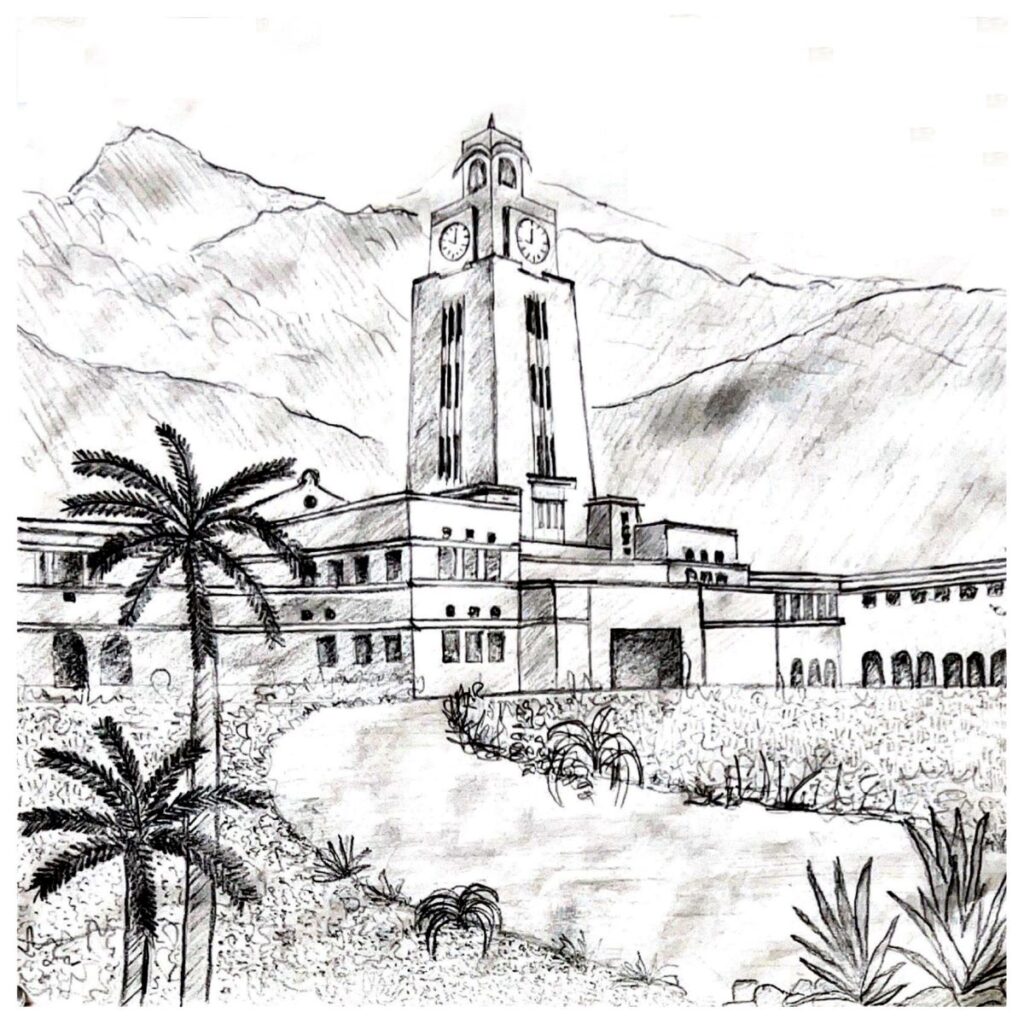

The Suspended Institute: Learning Beyond Earth
Speculative Campus Narrative by Drashti Desai
Time folds in the bioscope, revealing a campus no longer tethered to land but suspended between Earth and the Moon, just beyond the Van Allen Belt. As the planet’s surface became uninhabitable, learning ascended into orbit. Here, gravitational tethers anchor a constellation of research pods, laboratories, and living quarters, all interconnected by floating walkways. A central vertical spine houses high-speed elevators, linking the institute to Earth and supporting a self-sustaining ecosystem in space.
Drashti’s vision offers a bold rethinking of education’s future. This is not merely a retreat from collapse, but a leap into planetary transcendence. The Suspended Institute embodies a layer of human adaptability, where spatial imagination, technological innovation, and academic pursuit converge in zero gravity. In this speculative leap, the university becomes a floating archive of Earth’s memory and a launchpad for futures yet to be written.
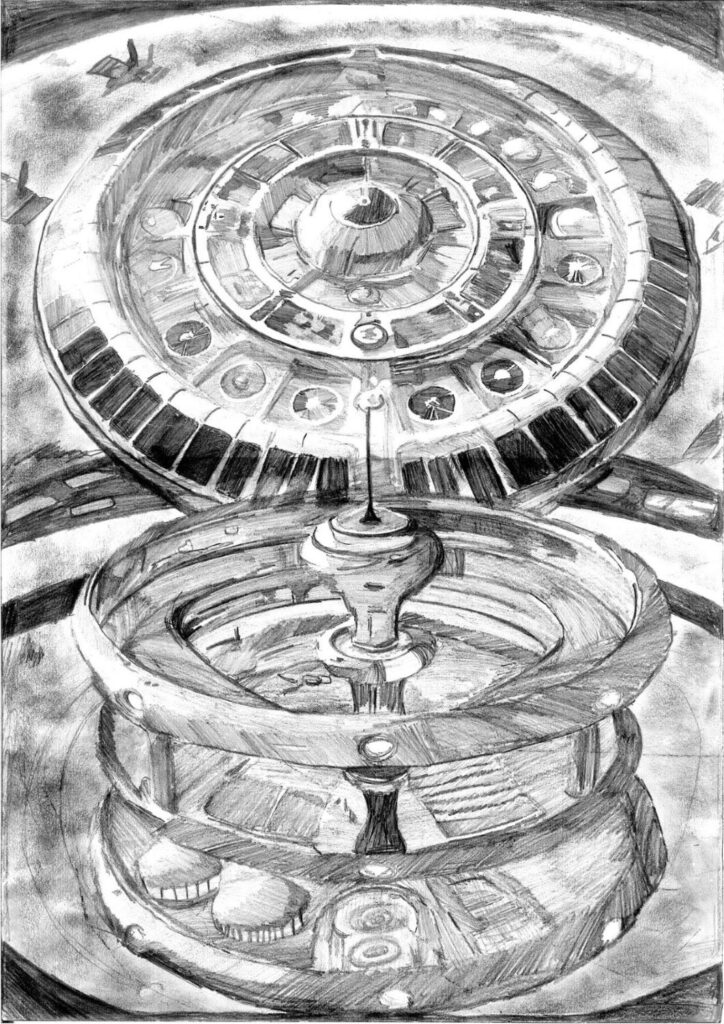

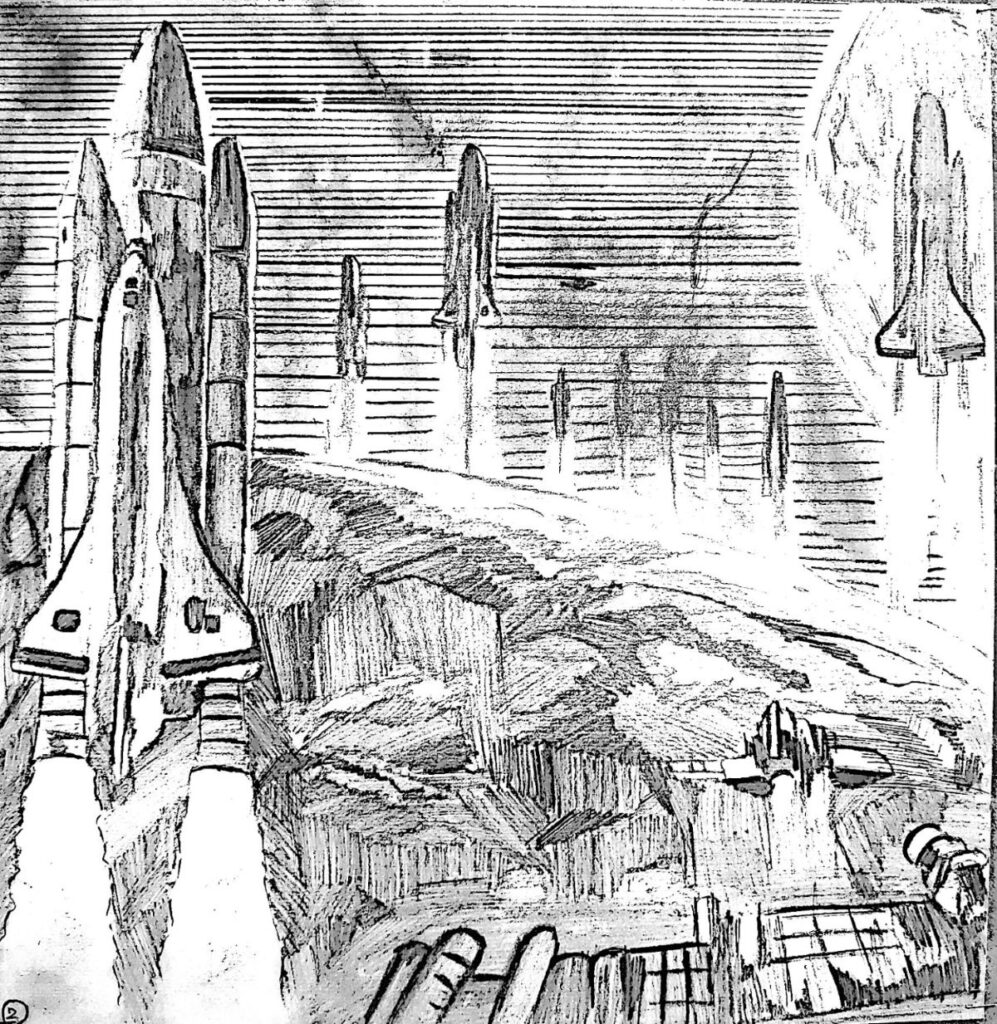

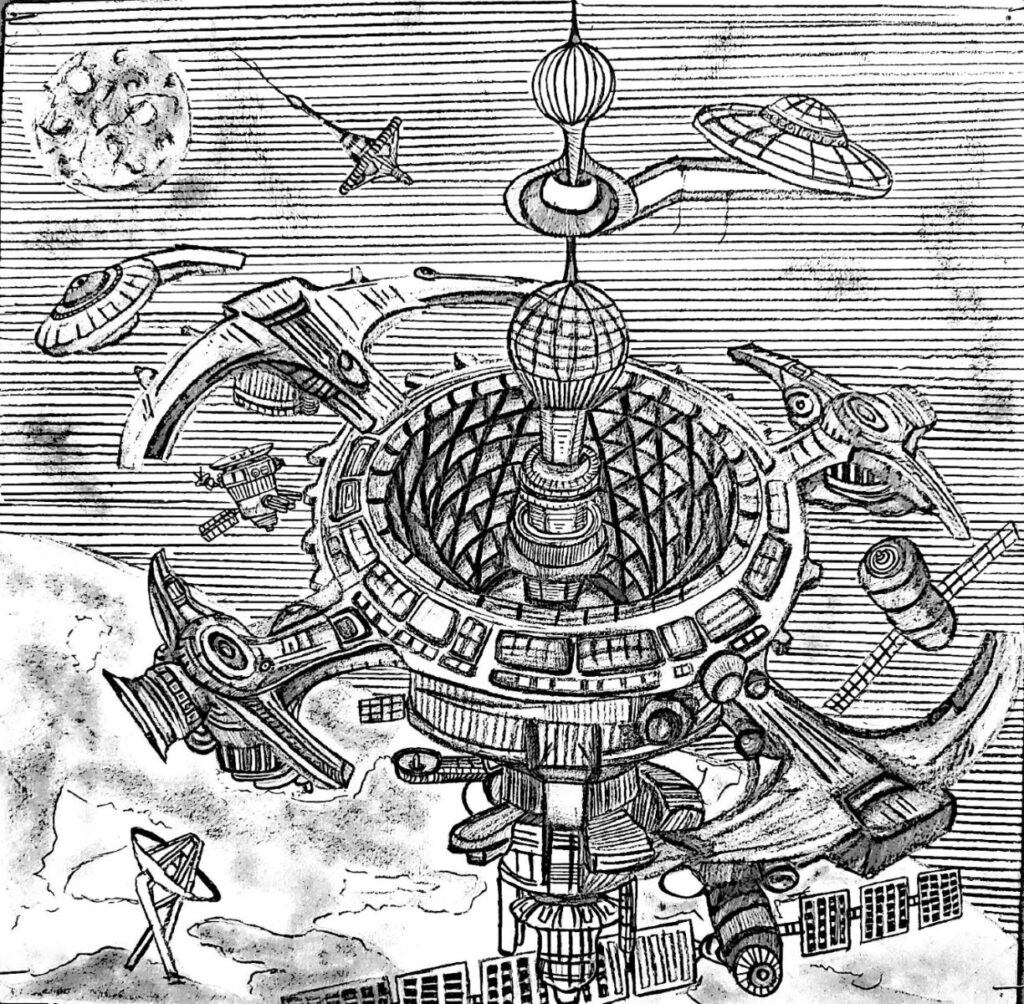

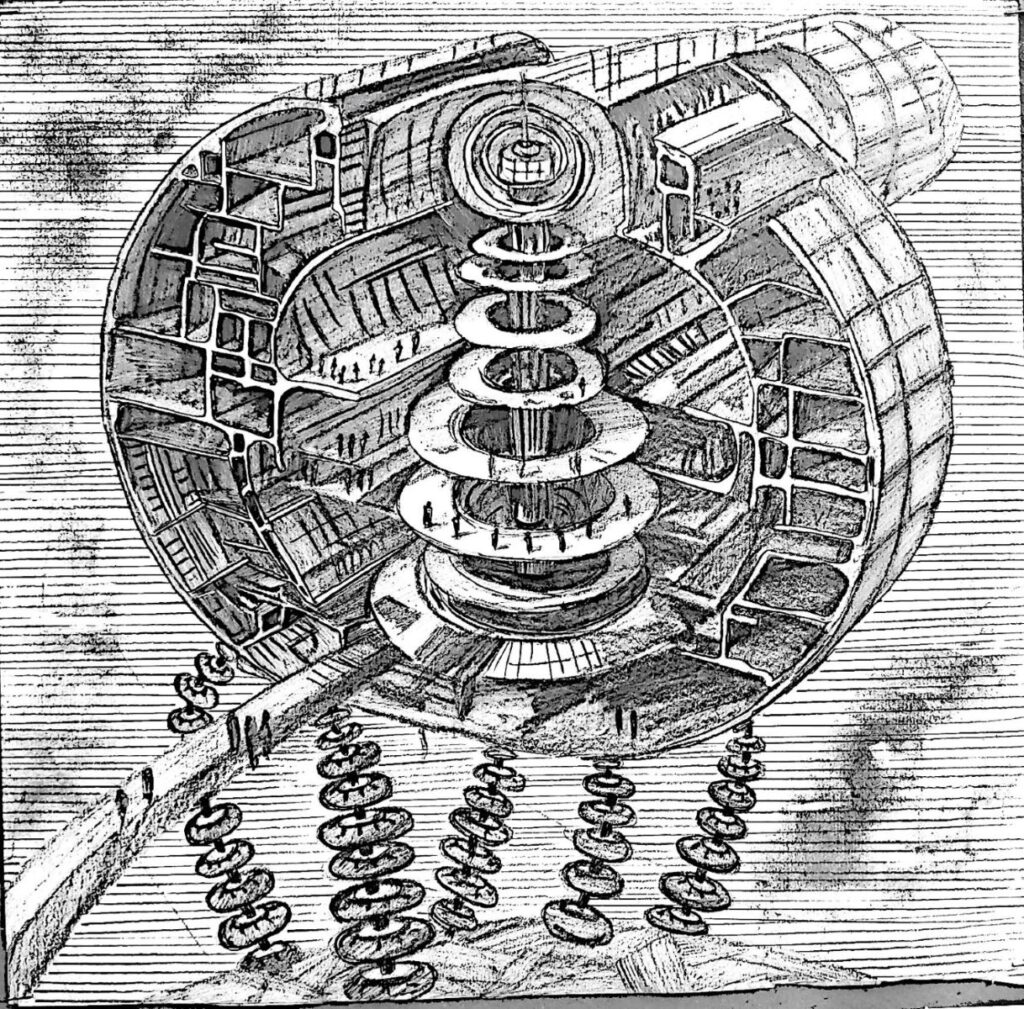
Delhi’s Alien Metamorphosis
Speculative Campus Narrative by Prachi Shah
In this imagined future, Prachi Shah maps a post-apocalyptic palimpsest where loss becomes the architecture of reinvention, and the unfamiliar becomes a catalyst for imagining new ways of inhabiting the city.
In her version, Delhi is no longer the city we remember. Tunnels unearth forgotten histories, alien spires loom over the remnants of empire, and a solitary clock tower marks the rhythm of time lost and reclaimed. In a moment, Delhi’s identity is rewritten.
Towering extraterrestrial structures pulse with an eerie, bioluminescent glow, connected by hovering walkways and gravity-defying platforms. Bamboo and wild grass intertwine with alien alloys, creating a hybrid terrain of ruin and rebirth. The surface fractures, and beneath it, survival finds shape in repurposed tunnels, once escape routes, now lifelines. India Gate, once a national emblem of resilience, stands shattered, its silhouette dissolved into the wreckage.
Yet from this collapse, new forms emerge, drawings that balance annihilation with adaptation, memory with transformation. The alien imprint is no longer foreign, it is embedded in Delhi’s very fabric.

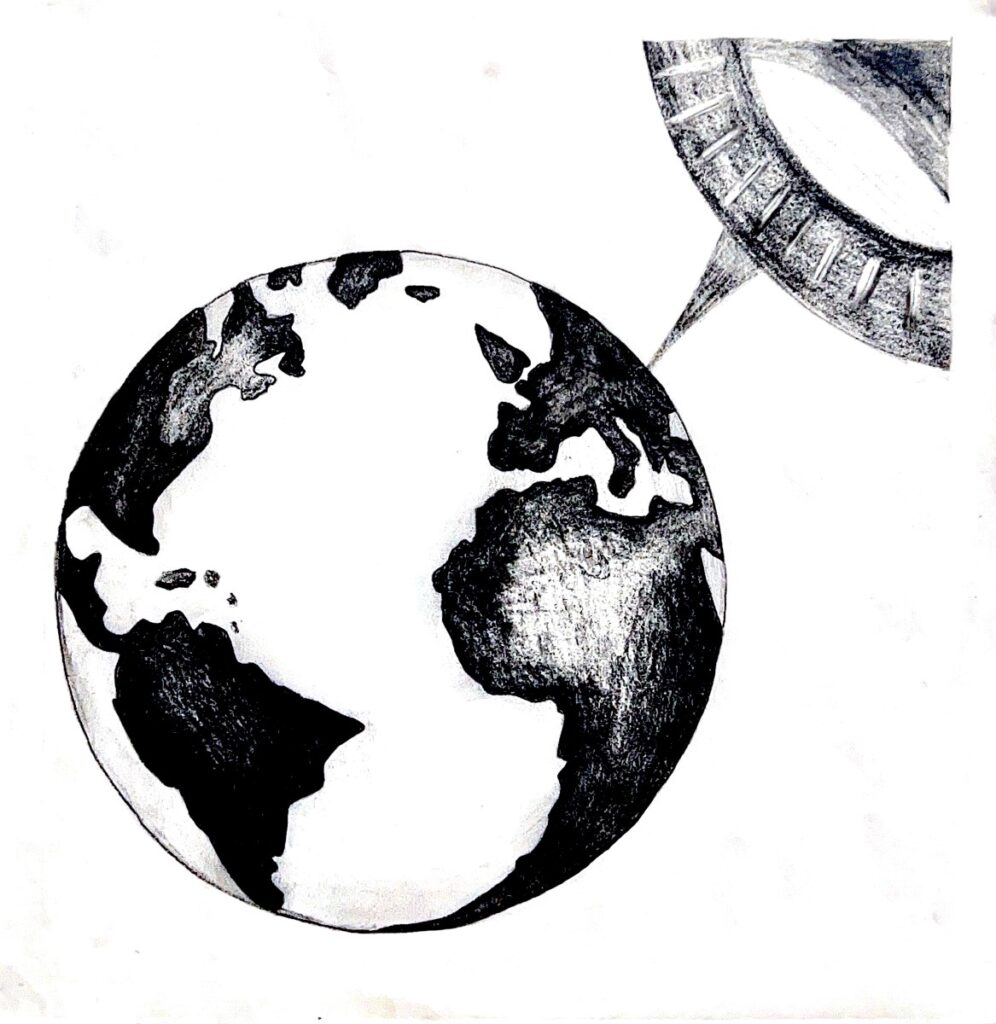





A Campus That Grows with Trees
Speculative Campus Narrative by Pushpendra Dudhat
Pushpendra envisioned a forgotten village, buried beneath layers of time, becoming the seedbed for a new kind of campus. Here, architecture does not overwrite nature; it listens, adapts, and grows alongside it. Through the bioscope, he captures rhythms of movement, decay, and regrowth. His drawing layers forgotten traces with emergent forms, where the past is not erased but re-rooted, forming an institution that grows as trees do: quietly, responsively, and resiliently.
In this imagined future, a floating campus emerges in the forest canopy. Suspended learning pods hang lightly among the trees, forming a decentralized network of spaces connected by meandering walkways. Learning unfolds not in isolation but within a living ecosystem, where ruins and roots cohabit, and knowledge is carried by wind, light, and shadow. At the heart of this landscape, a central gathering space fosters dialogue and collective memory. 3D-printed walls sprout from the forest floor, and skylights open to the sky above, allowing the architecture to breathe with its environment. This is a campus that evolves with its surroundings, not apart from them.






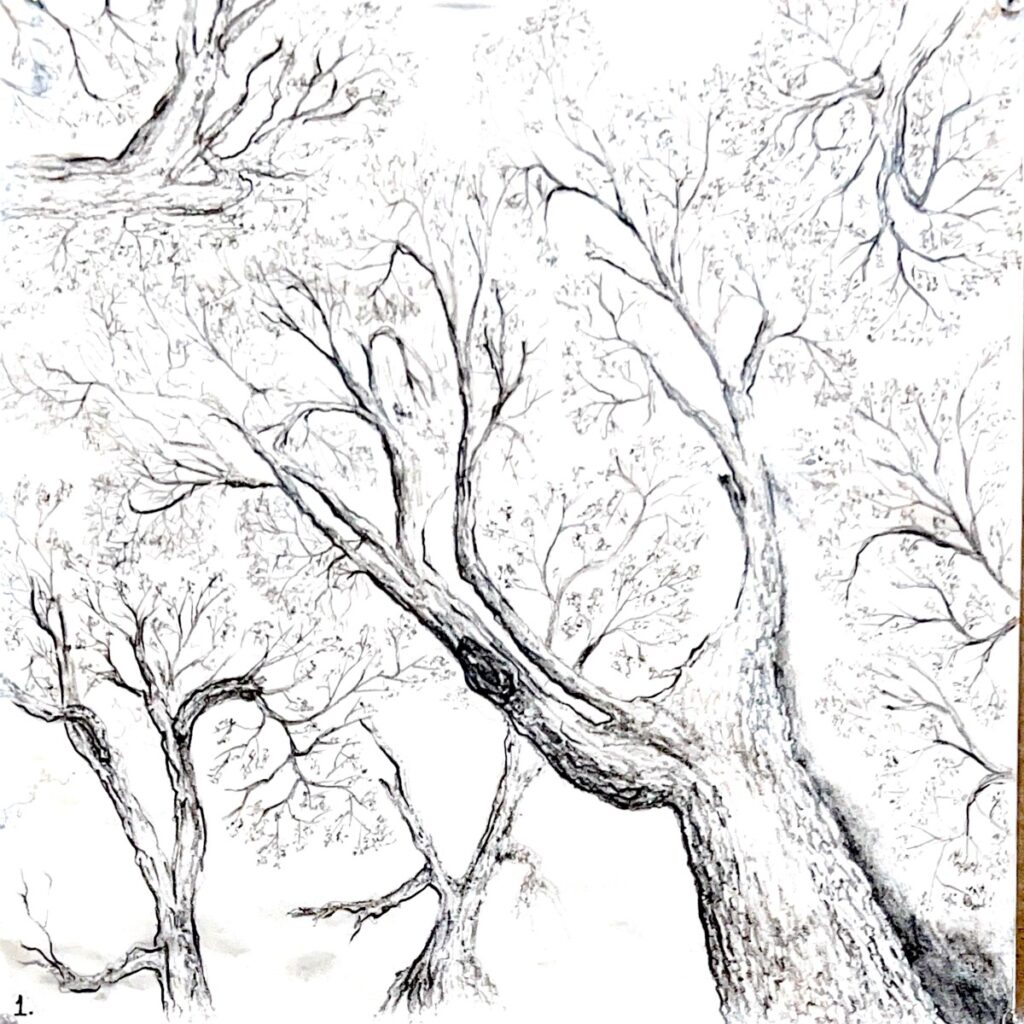
Learning Outcome
The speculative and narrative-driven approach developed in the studio is unique in its foregrounding of storyboards as a design tool. It implied adaptation by students to a new way of approaching design, expanding their imaginative instincts. The exercise served as a conceptual foundation for students to later experiment within the IIT Bombay context. With their perspectives broadened by this earlier exercise, students were better prepared to translate bold, imaginative thinking into practical, context-sensitive interventions. This studio experience fostered a mindset of resilience, creativity, and critical inquiry, anchoring storytelling at the core of transformative architectural practice.
Feature Image: © Rushit Shah

